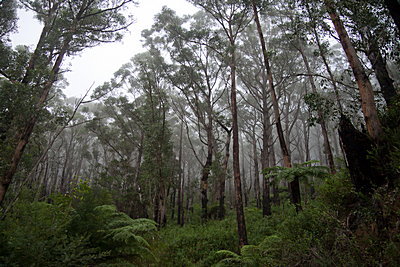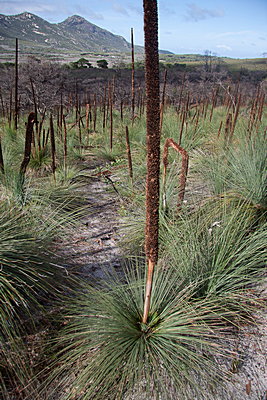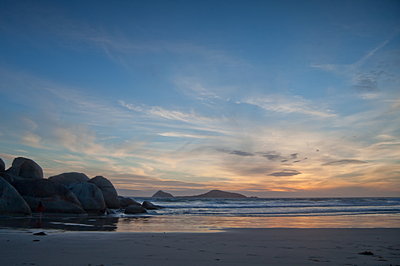
Looking north-west from Mt Oberon
Wilsons Promontory National Park – Wilsons Prom or just The Prom to many Victorians – is a national park in Victoria’s Gippsland region, two hours’ drive southeast of Melbourne. It combines great natural beauty with family accommodation. Photographers with families can keep the kids amused while indulging in their hobby. Hikers can walk for days, to destinations such as the lighthouse at the southernmost tip of the Australian mainland.
The Prom’s greatest photographic asset is the sheer variety of opportunities available in a five-kilometre radius of the main camping and accommodation site at Tidal River. Windswept surf beaches, cloud-topped mountains and verdant rainforest are all at hand. Indeed, from the right spot they can all be included in the same shot. You can shoot forest fungi and kangaroos, surfers and kids playing in the sand.
Tidal River
Your base will probably be the Tidal River settlement, which offers cabins as well as almost 500 camping and caravan sites. Book well ahead through Parks Victoria and be aware that campsites over the Christmas/January holidays are subject to a ballot. You will have to pay a small fee for entry to the park.
Once you’ve settled in, take stock of your options. Start by strolling over to Norman Bay Beach, just over the dunes. Note the offshore islands which will make a nice backdrop in long-lens shots out over the surf. Take in the views of nearby Mount Oberon and Mount Wilson. Then walk along Tidal River (frequently Tidal Stream or even Tidal Trickle) and back via the boardwalk to your accommodation. On the way you will find richly orange-tinted rocks that contrast with lush green vegetation behind them. An elegantly curved footbridge should yield interesting shots. There are people-photography opportunities to be had around the camping area, if you ask permission (very strongly advisable if shooting other people’s children) or are willing to risk upsetting your fellow campers.

Cool temperate rainforest on the slopes of Mt Oberon
Mount Oberon
Mount Oberon is best climbed from the Telegraph Saddle car park, which is a few minutes’ drive (or a much longer hike) up the road from Tidal River. The moderately steep but well-maintained 3.2-kilometre walk begins to the north-east of the mountain and turns back on itself as it rises. You’ll start in scrubland which will soon give way to taller eucalypt forest with mosses growing under soft ferns (dicksonia antarctica) up to four metres high. This part of the walk can be particularly rewarding in misty or rainy conditions. Large rocky expanses beside the track boast attractive mosses.
Near the top of the mountain you may find yourself clouded in, even in summer. Remember that the weather up here changes quickly and you may find the conditions clear within a half-hour. And you rarely get a chance to photograph at cloud level. Keep an eye out for changes in the cloudscape and you may find a memorable shot.
If the clouds stay away, you will soon come to more open conditions with views out to the north and east. These will seem impressive, but stop only for the best shots. The view from the summit is even better.

On Mt Oberon’s summit in the late afternoon light
The top of the mountain is reached by a staircase, at points cut directly into the rock, with a sturdy handrail. At the very top you will have to scramble up rocks. Take your time and tread very carefully to avoid damaging plant life. Depending on your fitness this stretch may seem like work, but the payoff is worth it.
When the rocks top out you will find yourself on a high ridge with views to the east, north and west. This is what you came for. The pre-sunset period presents wonderful and slightly unpredictable vistas. Some of my favorite shots came as the sun peeped out from under a low overcast. The rocks and small plants at your feet contrast wonderfully with the views beyond; try to get them both in a wide-angle view.
Make sure to work your way south along the rising ridge to the very top. Here you’re 558 metres above sea level, and you have 360 degree views, with the Southern Ocean visible to the east, south and west simultaneously. Out to the north-east is The Prom’s highest point, Mount Latrobe, at 754 metres. Go nuts with your wide-angle lens while you wait for the sunset. Keep shoot with progressively longer exposure times after the sun goes down. If your camera has a bulb mode, make sure you know how to use it.
Very early morning might well provide fine opportunities. I haven’t tried it yet. But the lie of the land suggests offers the best odds for spectacular photography.
Lilly Pilly Gully and Mount Wilson

Grass trees at the base of Mt Wilson
The area to the north-east of Tidal River may not be quite as eye-smacking as the best views from Mount Oberon, but its sheer variety is hard to beat. You start at the Lilly Pilly Gully car park, on your left as you drive back toward Melbourne from Tidal River. A well-constructed path takes you the 2.6 kilometres to the gully, across the base of Mount Wilson. To your south a plain full of grass trees makes for strong pictures. At the gully, a boardwalk takes you through ferny rainforest. You’ll want a lens that copes with low-light conditions here.
Once you’ve finished the gully, you have a choice: straight back to the car park, or the extra five kilometres up and down Mount Wilson, the looming hill to the west. Take the hard option and hike up Mt Wilson through forest and post-bushfire regrowth, rich with ferns and mosses. At the very top you’ll find vistas across to Mt Oberon and out across the beaches to the west.
The Lighthouse
The Wilsons Promontory Lighthouse is 19 kilometres from Tidal River. To get there, you’ll have to hike in and out with an overnight pack. The reward is vistas that less adventurous photographers cannot easily get. The Wilsons Prom light is as photogenic as most lighthouses. An added talking point: it’s the Australian mainland’s most southerly spot.
Lousy weather will make your long hike less pleasant but may pay off at the lighthouse itself. Wet and stormy weather adds mood to lighthouse shots; they’re in their element then. If you get a chance to shoot in the dusk as the light come on, take advantage of the brief period before the light overpowers its surroundings. As the sky darkens, you may want to try long exposures where you obscure the light as it points directly at the camera, to avoid blowing out the shot and to capture the surroundings.
Norman Bay Beach
Norman Bay, next to the Tidal River campsite, has forest, surf, rocky granitic outcrops and mountains in the background. It also has more people than any other part of The Prom.
Squeaky Beach
Named for the sound its white quartz sand makes under your feet, Squeaky Beach provides surf shots in abundance.
Whisky Beach
For many photographers, this is “the sunset beach”. The south end also offers interesting rocky outcrops. Depending on the day and season, you may have plenty of company as the sun goes down.
Special Equipment
You will want a wide-angle lens, and the wider the better. The shots on this page were mostly taken at the wide end of a Canon 17-85mm lens on an EF-S body, giving an equivalent focal length of 27mm. A wider lens such as the Canon EF-S 10-22mm f/3.5-4.5 USM would do better still. Even the low-res wide-angle camera on your mobile phone will yield shots that look impressive on Facebook.
A macro lens will let you take full advantage of the delicate, fine-scaled plants and mosses, as well as micro-fauna such as caterpillars and butterflies. A long lens (200mm-plus) will capture the many birds, from large parrots to tiny finches and wrens.

Mosses and mushrooms on the southern slopes of Mt Wilson
Swimming trunks and a protective case for your camera will open up nice opportunities in the surf at Norman Bay and Squeaky Beach. The north end of Norman Bay, for instance, has huge rocky outcrops rising out of the sand in the morning and covered in surf by mid-afternoon; wading into them at the right time should pay off. Alternatively you can use a water-resistant point-and-shoot such as Canon’s PowerShot D10.
For windy days on the beach, or rainy days in the forest, you may want to consider a plastic-bag-and-tape arrangement to protect your camera from the elements.
If you have any equipment for taking panoramas, this is the place to use it. The top of Mt Oberon offers views out to the sea west, south and east. At the entrance to Tidal River I came across a university photography lecturer and his class testing a panoramic set-up they had made themselves. At the very least, you may want to plan on taking a series of shots for later stitching. So pack a tripod if you have one.
Other equipment is fairly obvious. That tripod and a remote release (or your camera’s two-second delay setting) will let you take landscape shots in the gentle light at either end of the day. A polarizing filter will deepen the sky in beach shots during the daytime, if you like that look. Only some of the campsites are powered, so think about battery needs. Charged batteries and extra memory cards will let you shoot all the shots you want. You will likely want to shoot a lot.

In the rocks at the south end of Whisky Beach
Sturdy comfortable footwear will make the long walks easier. A hat, sunglasses and sunscreen will protect you from glare and UV rays. A rainproof coat will protect you from the fronts that roll in off the ocean. In winter, pack warm clothing; the southerlies arrive direct from Antarctica. In summer, pack a towel; the cool water beckons you in.
Special opportunities
In the right spot, you can take good shots from pre-sunrise to midday and on to the late dusk. Cloudy, misty and rainy weather can provide special opportunities at all times of day in the forests. However, the same old times offer the best odds for great shots. The west-facing beaches and the mountain peaks frequently provide dramatic skies in the evening. Sunrise can cast a golden light on the orange rocks and lush bush at the entrance to Tidal River.
The granite rocks of The Prom are magnificently textured. You’ll find them useful in the foregrounds of wide-angle landscape shots.
If you are camping at The Prom and the moon is not up, you have an opportunity to shoot at night into a sky unpolluted by smoke or artificial light. Astrophotography can involve expensive star-tracking equipment and lens mounts, but you can cheat using a succession of short shots plus software such as DeepSkyStacker. Or you can go down to the shore, crank up your exposure time to 15 minutes-plus, and photograph star trails while the surf creates surreal foreground effects.
Getting There
The Prom is a straightforward two-hour car trip from Melbourne on freeways and well-maintained main roads. The second half of this trip may yield its own opportunities, especially if you are willing to turn onto the back roads.
You will have to pay for entry to the park.
Further Inspiration
For more ideas, take a look at the hundreds of shots in Flickr’s Wilsons Promontory Pool.







Hi David,
Thanks for the time you took to write this review.
It is very informative.
Cameron